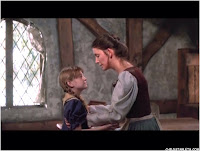http://i2.wp.com/www.tor.com/wp-content/uploads/2014/12/HP-goblet.gif?fit=500%2C%209999&crop=0%2C0%2C100%2C398px
Nonetheless, the same principal applies to the Grimm's tale, Hänsel and Gretel, and the 1987 MGM movie adaptation.
The biggest and most influential discrepancy (in my opinion) is CHARACTERIZATION. Which inevitably leads to the deterioration of the tales underlying themes.
In the Grimm's tale, the mother is depicted as an embodiment of evil. Zipes even mentions in his article "The Rationalization of Abandonment and Abuse in Fairy Tales: The Case of Hansel and Gretel," that the demeanor of the mother and the witch are interchangeable. Both characters even die at the end (though the mother doesn't in the film).
The mother in the film is not as evil and cold-hearted as she is described in the original tale. Sure she is vindictive and makes some utterly cruel comments to and about her children, but she very obviously loves them. When she realizes the children are missing she is truly heartbroken and blames herself. The mother does not purposely abandon Hansel and Gretel, but momentarily sends them away, unaware that they would venture deep into the forest to be captured by a witch. The false characterization of the mother completely diminishes the theme of abandonment displayed in the story.
http://www.childstarlets.com/captures/videocaps/nstapleton/hansel/nshansel036.jpg
 One of the morals to be taken from the Grimm's tale is the knowledge that having faith in God will help you overcome evil. The children are essential in the implementation of this theme. However in the MGM film, the father is the only character vocalizing the need to trust God during their time of hardship. Fairy tales are written in such a way for children to accept the social structures of the time (Zeitgeist), which Rüdiger Steinlein refers to as "domestication of the imagination." This element of the story is eliminated in the film, due to the fact that Hansel and Gretel are not exemplifying that their own "goodness" and Christian faith is what overcomes the witch.
One of the morals to be taken from the Grimm's tale is the knowledge that having faith in God will help you overcome evil. The children are essential in the implementation of this theme. However in the MGM film, the father is the only character vocalizing the need to trust God during their time of hardship. Fairy tales are written in such a way for children to accept the social structures of the time (Zeitgeist), which Rüdiger Steinlein refers to as "domestication of the imagination." This element of the story is eliminated in the film, due to the fact that Hansel and Gretel are not exemplifying that their own "goodness" and Christian faith is what overcomes the witch.http://41.media.tumblr.com/tumblr_lutmwzSTPi1r6embzo1_500.jpg
Many people argue that the tale of Hansel & Gretel is exhibited as a coming of age story. The children must learn to fend for themselves, grow up, and use their brains to get out of harms way (without the help of their parents). The pinnacle scene on which this theme lays is when Gretel uses her quick wit to con the witch and push her into the burning oven.
The MGM film uses charm and magic instead of the children's cunning to kill the witch. Although Hansel still uses the chicken bone to trick the witch into prolonging the time before she eats him, but Gretel's power is ultimately usurped. Instead of using her own intelligence, Gretel grabs the witch's staff and performs her own spell in order to kill her.
http://i.ytimg.com/vi/efyLnijCvEI/hqdefault.jpg
There are other small variations such as: the children only going out to the forest once, the witch's house being made of gingerbread, the father searching for the kids, Hansel and Gretel not taking jewels from the witch's house, and the addition of other children being saved.
The film does follow the original plot closely (though scenes were added to lengthen the story). But I would argue that the archetypes that make this fairy tale a classic were ignored.
The directors edited the tale in order to maximize their audience. By creating a family friendly movie, filled with songs and light-hearted attitudes, viewers are able to overlook the dark, underlying themes and simply enjoy a good story.
Zipes, Jack. "The Rationalization of Abandonment and Abuse in Fairy Tales:
The Case of Hansel and Gretel." Happily Ever After: Fairy Tales, Children,
and the Cultural Industry. New York and London: Routledge, 1997. 39-60.
Print.



No comments:
Post a Comment